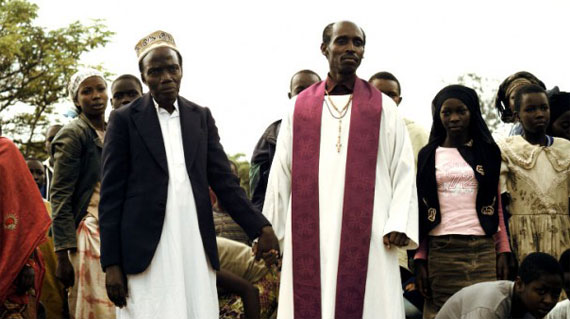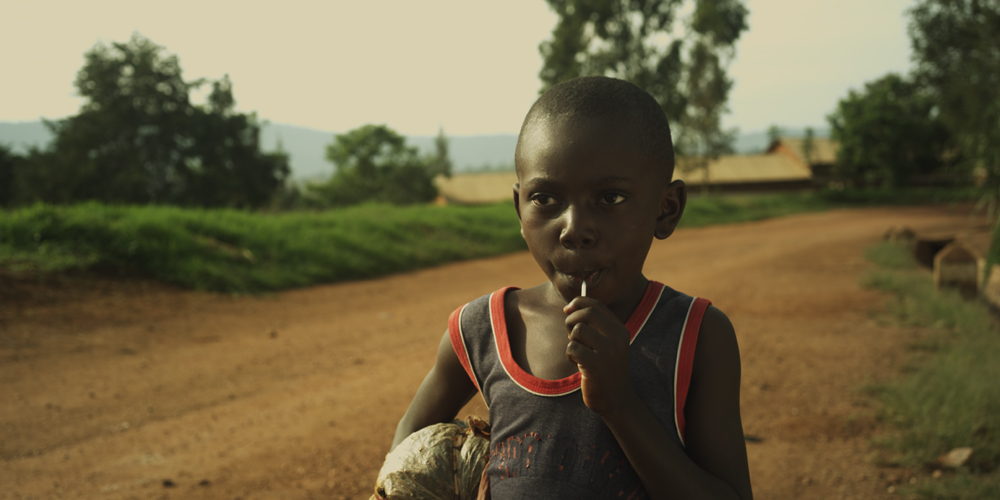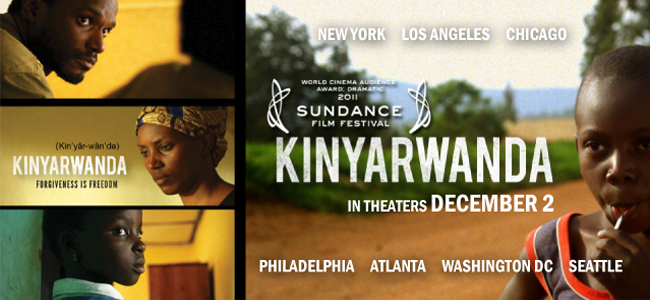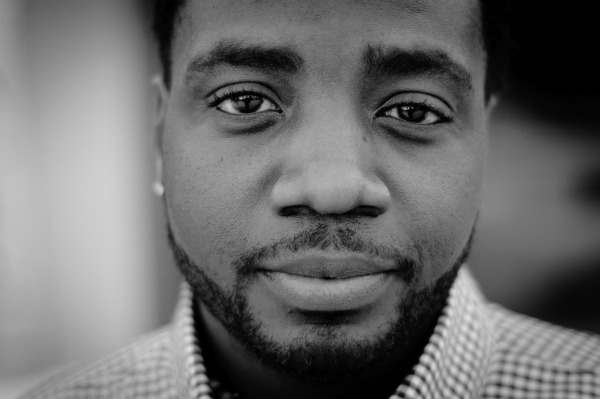@alricksporch @avadva @imagenation10
“Even if these names [Hutu and Tutsi] mean nothing, they are enough to get you killed.”
–Muslim Imam in Kinyarwanda
To the list of films like Hotel Rwanda and Sometimes in April that deal with the Rwandan genocide of 1994, add Alrick Brown’s feature debut Kinyarwanda. It’s a moving film that interweaves six different tales into a Rashomon-like narrative that enables the audience to ponder the existence and nature of evil, love, hate, resilience and forgiveness in the face of the unthinkable. In fact, Brown cites films such as Pulp Fiction, Amores Perros, and Crash as inspirations for the film’s structure.
We follow young lovers, a child, a couple, soldiers, the Imam, and a priest as they are swept up by the chaos of the world around them. We certainly meet heroes, but the villains are complicated. While you can’t excuse them for the things they do, by the end of the film, you’re able to see them in context.
 One of the unique aspects of the film is that it highlights the little known role that Muslims played during the atrocities. As the situation devolved, the Mufti of Rwanda, the most respected Muslim leader in the country, issued a fatwa forbidding Muslims from participating in the killing of the Tutsi. Mosques became places of refuge where Muslims and Christians, Hutus and Tutsis came together to protect each other. Kinyarwanda is based on true accounts from survivors who took refuge at the Grand Mosque of Kigali and the Imams who opened their doors to give refuge to the Tutsi and to those Hutu who refused to participate in the killing.
One of the unique aspects of the film is that it highlights the little known role that Muslims played during the atrocities. As the situation devolved, the Mufti of Rwanda, the most respected Muslim leader in the country, issued a fatwa forbidding Muslims from participating in the killing of the Tutsi. Mosques became places of refuge where Muslims and Christians, Hutus and Tutsis came together to protect each other. Kinyarwanda is based on true accounts from survivors who took refuge at the Grand Mosque of Kigali and the Imams who opened their doors to give refuge to the Tutsi and to those Hutu who refused to participate in the killing.
In the middle of the film, we’re treated to an animation sequence of a little boy playing soccer in a stadium in front of a crowd that roars as he scores a game-winning goal. It has that same pleasantly jarring effect as the color scene in Spike Lee’s She’s Gotta Have It. In this case, who ever expected to see playful animation in a film that’s set in the midst of genocide? When we come out of the animation, we see that it was all a daydream of a seven or eight-year-old boy who is kicking around a “soccer ball” made of garbage and tape. As Brown later commented during a Q&A: “When’s the last time you saw an African kid dreaming?”
I never understood was the real roots of the genocide. Based on a post screening discussion, I learned that the genocide was a consequence of colonialism. It was the Belgians who divided Rwandans. The Tutsis were educated and pushed into government and professional jobs where they and their families prospered. The Hutus, on the other hand, were the workers. Birth seemed to be destiny, as I’m assuming there was little to no upward mobility. Despite intermarriage, resentment simmered for decades. Then, with tensions already high, it was the assassination of Rwandan president Juvénal Habyarimana and Burundian president Cyprien Ntaryamira, whose plane was shot down at it prepared to land in Kigali that set the genocide in motion. According to the Wikipedia entry, responsibility for the assassination is disputed, so depending on who you talk to, it was either a Tutsi-affiliated group or one aligned with the Hutu.
This is one area I wish the film had explored a bit more. We are all familiar with the fact of the genocide, but less so with the causes beyond the fact that there were these tensions between the Tutsis and Hutus. A few minutes referencing the act that started the genocide would have done a lot to expand our limited understanding of that situation. That said, I understand that it’s important to start a film with an inciting incident, i.e., something that makes that day very different for all the characters involved. For this story, the assassinations might have thrown things off.
Director Brown (above) grew up in Plainfield, NJ, graduated from both NYU and Rutgers, and spent two years in the Peace Corps in the Ivory Coast, and these experiences gave him the grounding necessary to tell this story. This is cool on a number of levels, not the least of which is the fact that, I think, it’s rare to hear about black folks volunteering for the Peace Corps.
Kinyrawanda opened in eight (8) cities yesterday. The film is the second film to be distributed via AFFRM, the distribution collective put out the Ava DuVernay’s excellent I Will Follow earlier this year. As was the case with that film, Kinyarwanda takes advantage of the networks of the top black film festivals in the country to get films into theaters and in front of audience. It’s also important to reiterate that, from a distribution standpoint, it’s critical that people go see the film this weekend: It’s the first weekend’s boxoffice that determines whether or a film can hold a theater for a second week.
This is DIY taken to the next level. Instead of complaining about the lack of access and outlets for black film, the AFFRM collective has done something about it. What’s also great is that their purview isn’t just films from the US films, but films that take into account the global black experience.
Again, check out the cities and theaters via the AFFRM site here.
Additional link:



